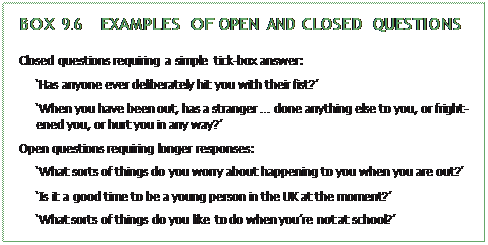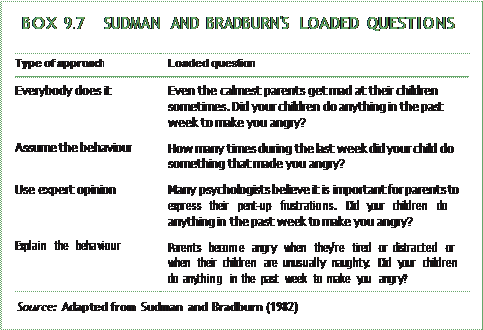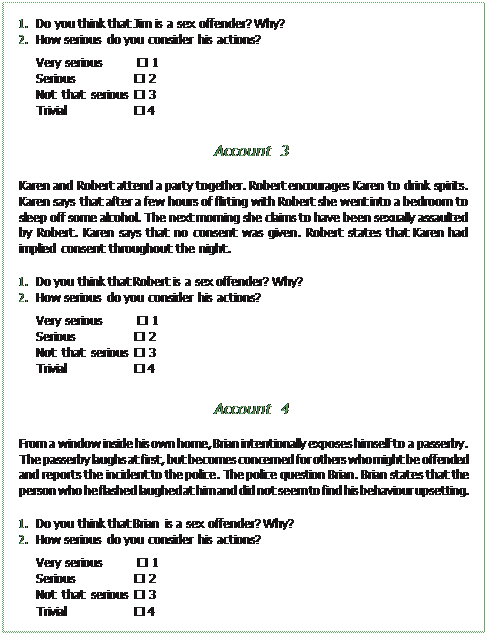 |
Open and closed questions. Long questions. Loaded questions. Vignettes
|
|
|
|
Open and closed questions
Closed questions containing pre-coded or ‘fixed-choice’ responses are useful to gather factual data such as personal background information, or data about events or behaviours. This data is often complete and easy to analyse. However, where sensi- tive topics are involved, closed questions can inhibit accurate reporting as respondents may avoid ticking the outermost response categories (Lee, 1993). Such problems can be circumvented by ensuring that response categories cover all possible behaviours and incorporate the extremes. To achieve the most appropriate closed questions, it can be helpful to take data from a small sample of respondents answering open ques- tions and use this knowledge to design closed-response questions for a larger sample (Gomm, 2004). This technique is called a pilot study and typically involves conduct- ing a number of qualitative interviews from which quantitative, fixed-choice questions may be generated.
Open questions can be more difficult to answer as respondents are required to write down a few words rather than tick one of a number of pre-given answers. However, open questions have the advantage of allowing the respondent to answer freely without being confined by a set of answers. This is particularly valuable in research focused on people’s experiences and perceptions. For example, it is more useful to ask someone to describe what it felt like to be sentenced to prison rather than to provide them with a list of emotions to tick. Both open and closed questions have a central place in survey research and are used effectively to draw out different types of information.
 |
Long questions
Sensitive research provides the exception to the rule about question length. It is com- monly believed that lengthy questions are detrimental on surveys, confusing the respondent and leading to hasty responses (Bryman, 2001). Longer questions allow the researcher to talk around the issue before asking the question so, with sensitive research, this may help to desensitize the topic (Lee, 1993) and a longer question may aid recall (Sudman and Bradburn, 1982). A word of warning: use them sparingly and only where necessary as respondents can become tired of reading or listening to lengthy questions.
Loaded questions
The tone of a question can have an effect on the response of respondents. Loaded questions are accused of leading the respondent towards a particular response
(Bryman, 2001); however, loaded questions can help a respondent feel more com- fortable when talking about an uncomfortable subject and provide a forum in which taboo behaviour can be revealed. Sudman and Bradburn (1982) describe four ways to load a sensitive question to achieve more accurate reporting of behaviour. The examples they provide are intended to encourage parents to discuss taboo feelings of anger towards their children (see Box 9. 7).
|
|
|
 |
Vignettes
Vignettes are an alternative to traditional questions and are used in surveys to reveal attitudes and behaviour. The main element of a vignette is a description of a scenario involving a number of key factors. However, there are different ways of using them in a survey. For example, Alexander and Becker (1978) describe the use of vignettes in a study concerned with rape victimization attitudes among police and nurses. The vignette described the attack but varied factors relating to the victim, for example marital status, relationship to the attacker, injuries sustained, and so on. In total, the variations produced 64 possible combinations that were distributed randomly across the sample of 680 respondents. Differences in attitudes between the two groups could then be measured by looking at the average response to each version of the vignette (Alexander and Becker, 1978).
Finch (1987) used vignettes in a qualitative study to establish family obligations. The vignettes follow a story that is presented in several stages, adding further information and with questions asking what the protagonists should do after each stage. The ques- tions were designed to allow the respondent to define a situation, and to reveal norms of behaviour. While she notes some problems with this method, particularly around recall of details as the story develops, Finch argues that using stages within a vignette allows the respondent to imagine how a story evolves (Finch, 1987).
Another approach to vignettes involves devising a set of different scenarios linked under a common theme that are distributed to each respondent. This the- matic approach can be useful as part of a pilot study or an exploratory investigation into a topic, particularly where definitions or perceptions of a particular term or activity are required. In our nationwide study of public attitudes towards sex offenders (see Survey Example 2, later in this chapter), we developed thematic vignettes to reveal opinions about the classification and severity of a range of offences (Brown et al., 2007). The vignettes provided respondents with an oppor- tunity to explore their thoughts on this sensitive topic whilst retaining an ‘outsider’ perspective (Box 9. 8).
 BOX 9. 8 VIGNETTES USED IN PUBLIC ATTITUDES TO SEX OFFENDER RESEARCH (BROWN ET AL., 2007)
BOX 9. 8 VIGNETTES USED IN PUBLIC ATTITUDES TO SEX OFFENDER RESEARCH (BROWN ET AL., 2007)
Account 1
Ted rents his house to a group of young professionals. Unknown to any of the tenants, Ted routinely records their bedrooms and bathroom via a digital camera system. He collects hours of footage per day and has videos dating back a number of years.
1. Do you think that Ted is a sex offender? Why?
2. How serious do you consider his actions?
Very serious ¨ 1
Serious ¨ 2 Not that serious ¨ 3 Trivial ¨ 4
Account 2
Jim lends his computer to Sarah for a couple of weeks while he is on holiday. Sarah finds a folder containing general pornographic material downloaded from the inter- net, and one of the pictures is of someone in their early teens.

These different approaches to the use of vignettes allow for the simulation of a situ- ation. This has the advantage of ‘desensitizing’ the topic and allowing the respondent to remain detached. However, one problem is that the use of a simulated scenario
|
|
|
may produce simulated responses that do not match up with what a respondent would do or think in a real situation. For this reason, Lee (1993) concludes that vignettes are best used to reveal ‘normative patterns’ (or how respondents think things ought to be), rather than actual behaviours. Despite the drawbacks, the vignette method is a popular tool of the survey researcher. It allows for creativity in the design process, can be shaped to fit sensitive issues very effectively and encour- ages respondent engagement in the survey.
Once the questionnaire has been devised, it should be ‘piloted’ to check that it operates effectively. Piloting involves testing the questionnaire with a small set of respondents that are comparable to the target respondents. As Bryman notes, pilot- ing ‘may be particularly crucial in relation to research based on the self-completion questionnaire, since there will not be an interviewer present to clear up any confu- sion’ (2001: 155). Problems with questionnaires and survey interview schedules can be identified through this process and alterations to the research instruments can be made.
|
|
|


